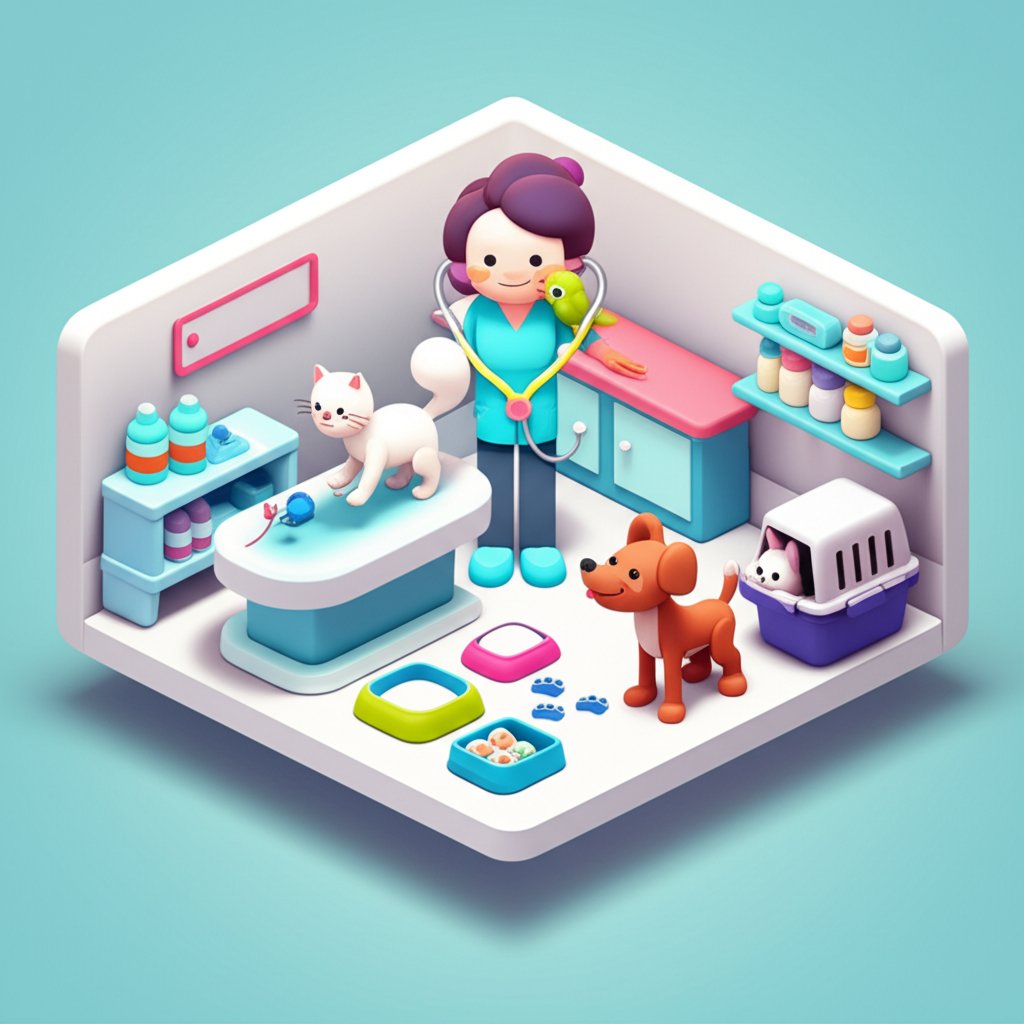Step right up, animal lovers and curious minds! Are you ready to dive headfirst into the extraordinary, often peculiar, and undeniably heartwarming world of veterinary care? Beyond the routine check-ups and vaccinations, a vast universe of vet facts awaits, filled with astonishing dedicated professionals. This article isn’t just a glimpse; it’s a deep exploration into the commitment, surprising realities, and profound animal care secrets that define the veterinary profession. We’ll unveil a collection of quirky vet facts and essential facts about vets that will leave you with a newfound appreciation for these unsung heroes and the incredible work they do for our beloved companions, our food sources, and even public health. Get ready to discover the magic and mastery behind keeping the animal kingdom healthy.
The Diverse Universe of Veterinary Care: Beyond the Exam Room

Veterinary care is far more complex and varied than many realize. It’s a demanding field that requires not only immense scientific knowledge but also boundless compassion and adaptability. The journey to becoming a veterinarian is arduous, and the daily reality is a dynamic blend of medicine, detective work, and emotional support.
To truly appreciate the dedication of these animal doctors, it’s worth uncovering more veterinary secrets that highlight the complexities of their daily work and the profound impact they have on animal welfare.
The Etymological Roots: What’s in a Name?
Let’s start with a foundational vet fact: the very word “veterinarian” has roots stretching back to ancient Rome. It originates from the Latin word “veterinae,” which translates to “working animals.” This ancient linguistic connection speaks volumes about the historical significance of animal care, initially focused on livestock that were crucial for agriculture, transport, and sustenance. Today, while the focus has broadened to include cherished pets, the essence of caring for animals vital to human life and well-being remains at the heart of the profession. This historical tidbit is one of many facts about vets that highlights their deep-seated connection to society.
A Spectrum of Specializations: From Exotics to Equine
The scope of animal care under the veterinary umbrella is truly astounding. It’s not just dogs and cats; veterinarians can specialize in a dizzying array of fields, each demanding unique expertise. Here are just a few:
- Companion Animal Vets: The most common, focusing on pets like dogs, cats, and small mammals. These are the practitioners most people interact with for routine
veterinary care. - Equine Vets: Masters of horse health, from performance horses to beloved ponies. Their work involves everything from lameness issues and dental care to managing breeding programs.
- Food Animal Vets (Livestock Vets): Essential for agriculture, these vets ensure the health and welfare of farm animals such as cattle, pigs, and sheep. Their role is critical for food safety and preventing widespread disease, a vital aspect of
animal carethat often goes unnoticed by the general public. - Exotic Animal Vets: Specialists in creatures great and small, from reptiles and birds to unusual pocket pets. These experts require a vast knowledge base to treat species with vastly different physiologies.
- Zoo and Wildlife Vets: Working with wild animals in captivity or in their natural habitats, these veterinarians are on the front lines of conservation and complex medical challenges for unique species. Their
veterinary careoften involves creative solutions for animals that cannot easily be handled. - Specialty Areas: Beyond species, vets can further specialize in cardiology, oncology, dermatology, ophthalmology, surgery, internal medicine, dentistry, and even behavioral medicine. These advanced specializations ensure comprehensive
animal carefor even the most complex conditions.
The Academic Journey: Years of Dedication and Skill
One of the sobering facts about vets is the sheer dedication required to join their ranks. Aspiring veterinarians typically undergo an average of eight grueling years of higher education, often more. This includes a bachelor’s degree followed by a demanding four-year Doctor of Veterinary Medicine (DVM) program. Many then pursue internships and residencies for specialized training, adding several more years. This rigorous academic path equips them with unparalleled skills in diagnostics, surgery, pharmacology, and patient management across a multitude of species – making veterinary care a truly expert-driven field.
Unveiling Quirky Vet Facts: Surprising Statistics and Daily Realities

Beneath the serious facade of medical expertise, the world of veterinary care is also peppered with quirky vet facts and surprising insights into the profession’s demographics and daily challenges. These facts offer a more personal glimpse into the lives of those dedicated to animal care.
The Female Frontier: A Dominant Force in Veterinary Medicine
Here’s one of the most compelling facts about vets: around 80% of veterinarians are women. This statistic represents a significant demographic shift over the past few decades. While historically male-dominated, veterinary medicine has seen a remarkable influx of women, making it one of the most female-prevalent STEM professions. This inspiring trend showcases the breaking of stereotypes and highlights the compassion, resilience, and intellectual prowess that women bring to the demanding field of animal care. It’s a quirky vet fact that speaks to evolving societal roles and the universal appeal of helping animals.
Dogs, Cats, and… Goats? The Most Common Patients
It might not be a huge surprise, but when it comes to the most popular animals showing up on the veterinary care exam table, dogs lead the pack. With approximately 65.1 million households in the United States owning a dog (according to the APPA 2023-2024 survey), canine companions are frequent visitors. Cats follow closely, making up a significant portion of a small animal vet’s caseload. However, a genuinely quirky vet fact is the sheer diversity practitioners might encounter, especially in mixed practices or rural areas. A vet might perform surgery on a dog in the morning, advise on goat nutrition in the afternoon, and tend to an exotic bird in the evening. This constant variety keeps animal care endlessly challenging and exciting.
More Than Just Pets: Public Health Protectors
While many associate vet facts primarily with pet health, a critical quirky vet fact reveals their profound impact on human well-being. A staggering 60-75% of all emerging human infectious diseases are zoonotic, meaning they originated in animals. This includes diseases like rabies, West Nile virus, Lyme disease, and even COVID-19. Veterinarians are often the first line of defense against these threats. Their work in monitoring animal populations, ensuring safe food supplies, and controlling animal diseases directly contributes to public health and global safety. This is a crucial, often overlooked, aspect of animal care that underscores the importance of the profession.
The Lifesaving Impact: How Vets Shape Animal and Human Health
The depth of veterinary care extends far beyond individual patient consultations. Veterinarians are integral to the broader ecosystem of health, playing a multifaceted role in securing a sustainable future for both animals and humanity. Their dedication to animal care often has ripple effects that benefit us all.
One Health, One Future: Bridging Animal and Human Wellness
The “One Health” concept recognizes that the health of people, animals, and our environment are interconnected. Veterinarians are central to this philosophy. By studying animal diseases, understanding their transmission, and developing treatments and prevention strategies, they directly protect human populations. For example, a vet fact illustrating this is their role in surveillance for diseases like avian influenza or mad cow disease, preventing their spread to humans. This holistic approach to veterinary care highlights that animal care isn’t just a compassionate act, but a societal imperative. It’s a powerful reminder of how facts about vets connect to our everyday lives.
Emergency & Critical Care: The Unsung Heroes of Crisis
When disaster strikes, be it a car accident, a sudden illness, or a toxic ingestion, emergency and critical care veterinarians are on the front lines, providing intensive veterinary care. These specialists often work round-the-clock, performing complex surgeries, managing life support, and making critical decisions under immense pressure. The mental fortitude and rapid problem-solving skills required in these high-stakes situations are profound facts about vets that showcase their resilience and expertise. They are the true lifesavers when every second counts for an animal in peril, offering animal care at its most challenging. One quirky vet fact here is the creative ways they adapt human medical equipment and techniques for diverse animal anatomies, from tiny kittens to massive Great Danes.
Preventive Medicine: A Stitch in Time for Animal Wellness
Perhaps the most impactful, yet least dramatic, aspect of veterinary care is preventive medicine. Regular check-ups, vaccinations, parasite control, and nutritional counseling are cornerstones of good animal care. These proactive measures prevent suffering, extend lives, and reduce the likelihood of costly emergency treatments. Veterinarians educate pet owners on the importance of these steps, empowering them to be active participants in their pet’s health journey. Simple vet facts like timely deworming or annual vaccine boosters can prevent devastating diseases, illustrating the power of prevention in animal care.
Behind the Scenes: The Lesser-Known Aspects of a Vet’s Life
While the public often sees the clean clinics and smiling faces, there’s a deeper, more challenging side to the veterinary care profession. Understanding these facts about vets helps truly appreciate their commitment and sacrifices.
The Emotional Toll: Compassion Fatigue and Resilience
One of the less happy quirky vet facts is the high rate of compassion fatigue and mental health struggles within the profession. Veterinarians routinely face difficult decisions, deliver heartbreaking news, and witness animal suffering, often feeling immense personal responsibility. The emotional intensity of providing animal care, coupled with long hours and the financial pressures on clients, can take a significant toll. This aspect of veterinary care highlights the incredible empathy and resilience required by vets, who often put their patients’ needs above their own emotional well-being. Support systems and mental health awareness are becoming increasingly vital vet facts within the community.
Technological Advancements in Animal Diagnostics
Modern veterinary care benefits from astonishing technological innovations. What many might perceive as quirky vet facts are actually sophisticated tools routinely used in animal care. Advanced diagnostics like MRI, CT scans, ultrasound, endoscopy, and sophisticated blood work provide veterinarians with unprecedented insights into an animal’s internal health. These technologies, often adapted from human medicine, allow for earlier and more accurate diagnoses, leading to more effective treatments and better outcomes in veterinary care. The ability to diagnose a subtle spinal issue in a cat or detect early-stage cancer in a horse demonstrates the cutting-edge nature of today’s animal care.
Global Outreach: Vets Without Borders
Another inspiring dimension to facts about vets is their global impact. Organizations like “Vets Without Borders” (analogous to Doctors Without Borders) send veterinarians to developing nations or disaster zones to provide essential animal care, combat disease outbreaks, and support sustainable agriculture. This global veterinary care extends beyond individual animals to entire communities, preventing zoonotic diseases and securing livelihoods. It’s a testament to the selfless dedication that characterizes many in the profession, revealing quirky vet facts about their willingness to serve animals and people in the most challenging environments.
Conclusion: Celebrating the Unsung Heroes of Animal Health
From the Latin origins of their title to their pivotal role in global public health, veterinary care professionals are truly extraordinary. They are scientists, surgeons, compassionate counselors, and tireless advocates for animal care. We’ve delved into vet facts both profound and practical, exploring the diverse specializations, the grueling educational path, and the emotional resilience that define these remarkable individuals. The quirky vet facts about their demographics and daily challenges only deepen our understanding of their immense contributions.
The next time you encounter a veterinarian, remember these insights into their world. They are not just healers of our beloved pets but guardians of a broader ecosystem, protecting both animal and human health. Let’s celebrate these unsung heroes and continue to support the vital work of animal care that enriches our lives in countless ways. Their dedication ensures a healthier, happier world for all creatures, great and small.
FAQ: Your Questions About Veterinary Care Answered
Q1: What is the primary role of a veterinarian?
A1: The primary role of a veterinarian is to promote animal health and welfare. This encompasses diagnosing and treating animal diseases, preventing the spread of illness (including zoonotic diseases to humans), performing surgery, providing preventive veterinary care, and educating animal owners on optimal animal care practices.
Q2: How long does it typically take to become a veterinarian?
A2: Becoming a veterinarian typically requires extensive education, usually around 8 years of post-secondary schooling. This includes a bachelor’s degree (4 years) followed by a Doctor of Veterinary Medicine (DVM) degree from an accredited veterinary school (another 4 years). Specializations can add further years of internships and residencies.
Q3: What are some quirky vet facts about the veterinary profession?
A3: Some quirky vet facts include that approximately 80% of veterinarians are women, a significant shift in recent decades. Also, veterinarians play a crucial role in public health because 60-75% of emerging human diseases are zoonotic (originate in animals). They also treat an incredibly diverse range of species, from common pets to exotic wildlife and livestock.
Q4: Why is animal care important beyond just pet health?
A4: Animal care is vital for public health, food safety, and environmental conservation. Veterinarians ensure the health of livestock, which directly impacts the safety and availability of our food supply. Their work also prevents the spread of zoonotic diseases to humans and contributes to the conservation of endangered species and biodiversity through wildlife medicine.
Q5: What is the “One Health” concept and how do facts about vets relate to it?
A5: The “One Health” concept recognizes that the health of humans, animals, and the environment are inextricably linked. Facts about vets demonstrate their central role in this concept, as they work at the intersection of these three pillars by monitoring and controlling animal diseases, ensuring food safety, and contributing to environmental health, thereby protecting all forms of life.
Q6: Do veterinarians only treat household pets?
A6: No, veterinary care extends far beyond just household pets. Veterinarians specialize in many areas, including equine (horses), farm animals (livestock like cattle, pigs, sheep), exotic animals (reptiles, birds, small mammals), and even zoo and wildlife species. Their expertise is vital across the entire animal kingdom.









